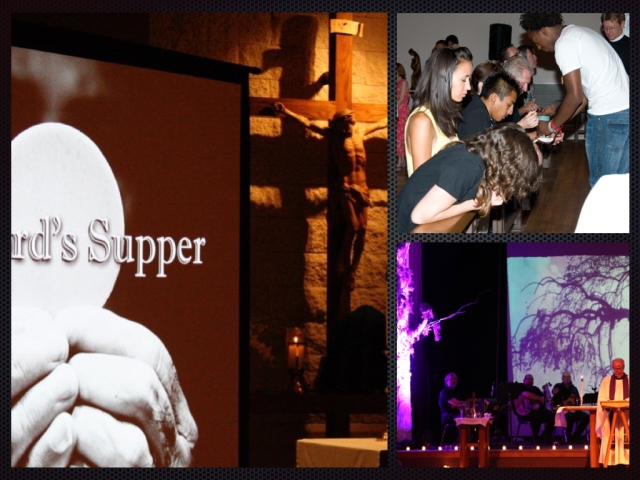

“…The Church’s liturgical worship expresses and impresses the personality of Christ upon us.” -Mark Galli, Beyond Smells and Bells
Contemporary liturgical worship is not an oxymoron. It is a blend of “immersive” worship music within the scaffolding of ancient Christian “participatory” liturgy. Led by a liturgical leader but with music driven by a band, contemporary liturgical worship maintains one foot in cultural familiarity, and the other in the formative, embodied worship of the ancient church. This is a blend of sacred act and contextual music, with art and artful leadership. Worship, in a liturgical context is uniting “ourselves with others to acknowledge the holiness of God, to hear God’s word, to offer prayer, and to celebrate the sacraments.” (BCP 857) Contemporary evangelicalism has realized that one can do most of that without the historic Christian liturgy. But liturgy has more than the emotional function, it has a discipleship function as well. The twofold shape of Word and Sacrament liturgy models the Christian life: we read, sing, pray, and proclaim the word. Then we respond to the word in affirming our faith, confessing our sins, interceding on behalf of the world and being reconciled to one another. Then we present ourselves to Jesus at his table, in celebration of our reconciliation with God. Weekly we are nourished on his body broken, and we imprint the story of Jesus on our hearts following the annual rhythm of the Christian year. So, worship leader friends, embrace the liturgy your parents threw out – There is a baby in that bath water!
But how does one make worship both accessible to a contemporary audience without sacrificing the formative power of the liturgy? Here are 10 Principles for leading services that are both contemporary and liturgical:
10 Principles for Contemporary Liturgical Worship
- Start with Love. Too often the contemporary church is providing transcendent pastors and relevant experiences. We were far better off with the opposite: transcendent worship and relevant (grounded, down to earth, invested and involved) leaders. Evangelicals and progressive clergy alike seem to be trading shepherd for celebrity. Start your worship planning with a heart for God and the people God has placed in your care.
- Know your audience. Do you have a crowd needing to hear Easter or Good Friday preached? Less educated neighborhoods usually do not do Elizabethan English, but suburban college kids often are engaged by it. Bluegrass worship won’t play in West Phoenix. And Hip/Hop won’t go over well in Asheville. Liturgical worship has familiar words, but Christianity has always been contextualized. Three ways your congregation will be shaped: The faces they see up front, the musical genres you play, and message you proclaim.
- Monitor the messages you are sending. Contemporary liturgical worship is supposed to be outsider accessible. Are you using insider vs outsider language? Do you have “reserved” parking, pre-prepared name tags, and other things that paint people into insider and outsider categories? Are you assuming people know how to use prayer books and can juggle bulletins or are you giving directions to their use?
- Simplify the liturgical playbook. But do so without sacrificing the internal coherence of the liturgy.
- Fuse contemporary forms to the liturgy. Use the musical genres, instruments, visuals and videos from your context. Invite the young and artful to help you!
- Embody your worship. Teach the historic faith in word and ritual. The more whole body your worship the better. (Hand raising and genuflecting both have embodied worship in common, so do incense and smoke machines. Use ritual to teach the faith.)
- Music is missional. Use the musical genres of those you want to come. Some principles for music:
- Hymn’s rock
- Blend genres. Your Sunday music should sound like your audience’s Monday through Saturday playlist!
- Avoid the Parent Trap: Don’t use their parents’ worship music. No Shine Jesus Shine. Use music written less than ten years ago or more than fifty.)
- Use your organ! (Djimbe, guitar, violin, flute and electric guitar all sound great with the organ.)
- Teach how and why to worship.
- Quality over genre! Good is always good. Lame is always lame. Use good musicians and vocalists…but don’t use them until they are ready.
- Message:
- Preach with passion. People are watching too many TED talks to live through low energy communication.
- An image driven or story driven sermon is a memorable sermon.
- Theological! Don’t skimp on the orthodoxy. The fastest growing churches offer stronger content, and ask for higher commitment.
- Less politically directive, more open. (the Gospel certainly has political implications, but trust the Holy Spirit to tell people what their politics should be.)
- Know and articulate regularly the simple, life-changing gospel
- Don’t get caught with a contemporary message. Jesus didn’t come to include us. He came to redeem us. Neither did he come to give us “purpose,” or “Your Best Life Now.” He came to transform us into the image of his son. (Rom 8:29, 2 Cor 3:18)
- Vibe:
- Make it happen. Use darkness and light, video and graphics. You can do a lot in a contemporary space to create a sense of the rhythms of the Christian life. For example, in our gym we do far more seasonal adjustments to our space than we can do in our church’s more traditional space (examples below). Use the tools of the tradition: Annual art, colors, symbols.
- The space always wins. You cannot overcome your architecture. For example, a fast preacher cannot be heard in a traditional space tuned for organ and choir with a 1.5 second auditory delay. However, you can use lighting, color and graphics to change alter your space.
- Service length? Our school and the media have trained a 60 minute attention span into most folk.
- The liturgy tells stories. Tell them artfully!
- Don’t fear ancient. In our unrooted, ever-changing world, the church is the one place that should be dependable. You don’t want to be their parents’ church. But you do want to be their grandparents’ church!
- Summing it up: Update your music, vibe, and word choice. Not your liturgy or theology. Worship with brain & body. IOW…Preach like an evangelical, worship like a catholic – artfully!
Examples of altering a contemporary space seasonally
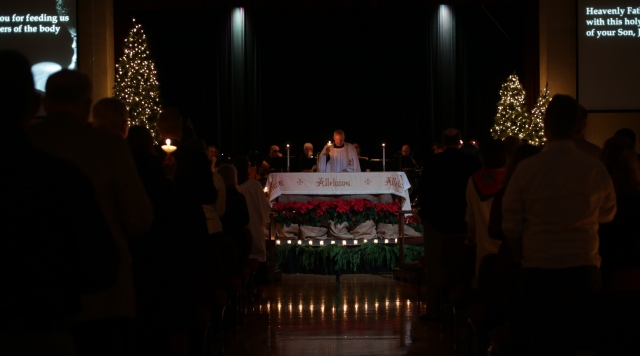
Celtic Christmas Eve

12 Days: Christmas in Bethlehem
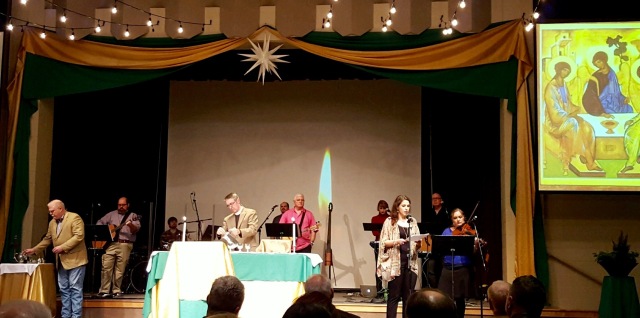
Epiphany
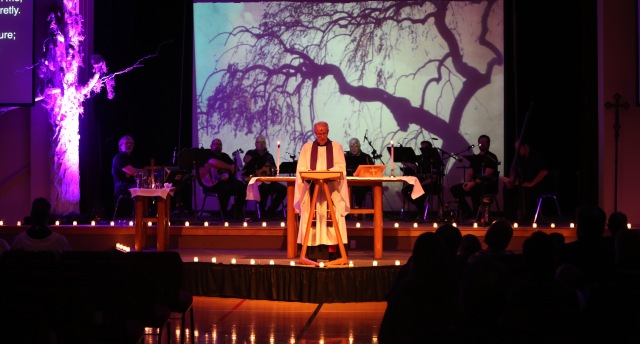
Ash Wednesday
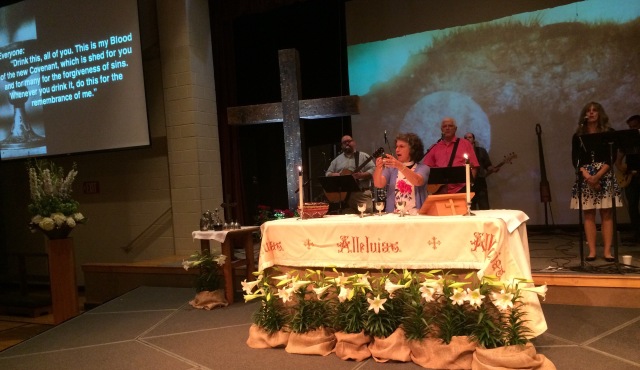
Easter (empty tomb)

Ordinary Time
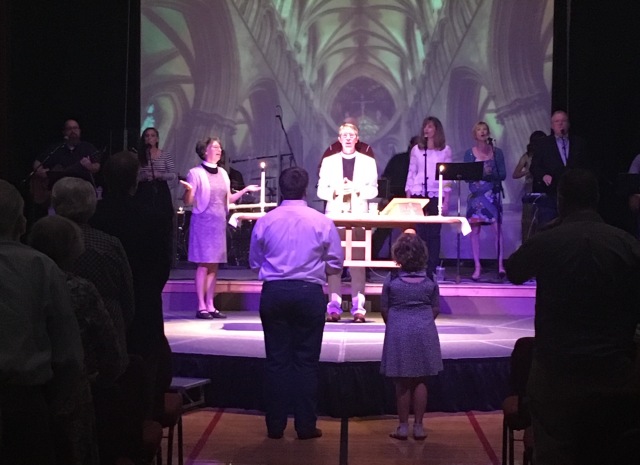
Cathedral